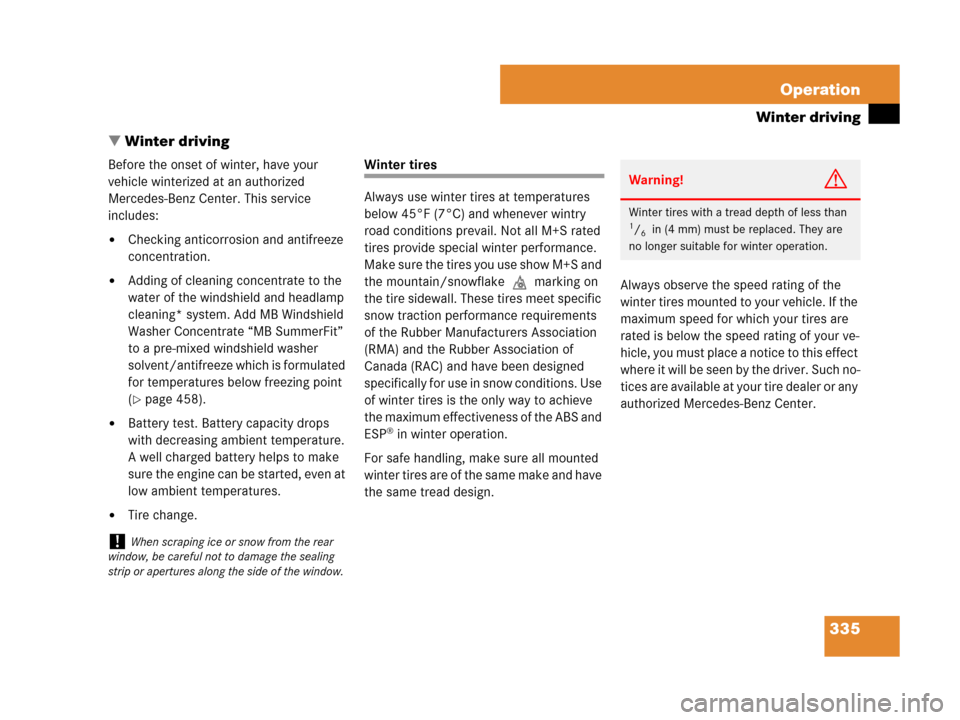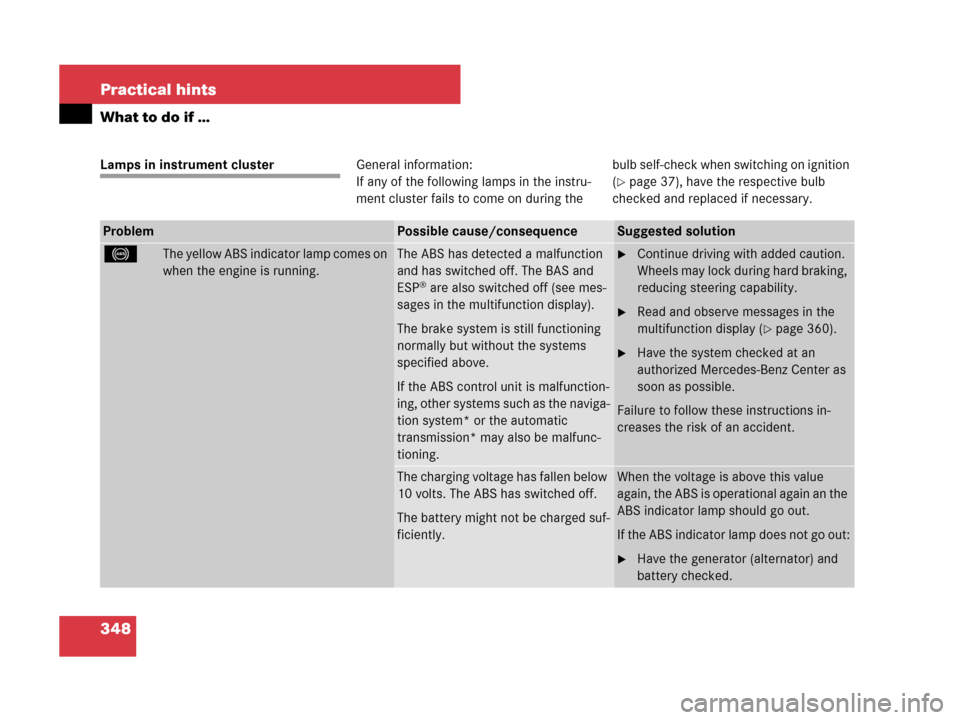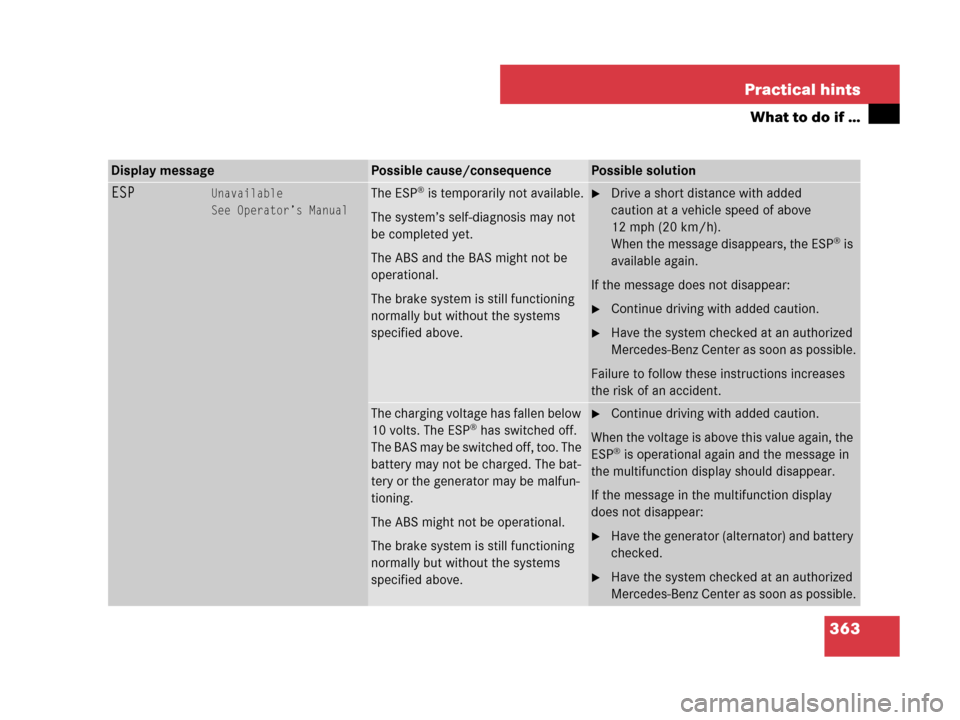Page 304 of 474
303 Operation
Engine compartment
Batteries contain materials that can harm
the environment if disposed of improperly.
Recycling of batteries is the preferred
method of disposal. Many states require
sellers of batteries to accept old batteries
for recycling.
Warning!G
Observe all safety instructions and precau-
tions when handling automotive batteries.
Risk of explosion.
Fire, open flames and smoking
are prohibited when handling
batteries. Avoid creating sparks.
Battery acid is caustic. Do not
allow it to come into contact
with skin, eyes or clothing.
Wear suitable protective cloth-
ing, especially gloves, apron and
faceguard.
Wear eye protection.
Rinse any acid spills immediate-
ly with clear water. Contact a
physician if necessary.
Keep children away.
Follow the instructions in this
Operator’s Manual.
Page 333 of 474

332 Operation
Tires and wheels
GVWR (Gross Vehicle Weight Rating)
This is the maximum permissible vehicle
weight of the fully loaded vehicle (weight of
the vehicle including all options, passen-
gers, fuel, and cargo and, if applicable,
trailer tongue load). It is indicated on
certification label located on the driver’s
door B-pillar.
Kilopascal (kPa)
The metric unit for air pressure. There are
6.9 kPa to 1 psi; another metric unit for air
pressure is bars. There are 100 kilopascals
(kPa) to 1 bar.
Maximum load rating
The maximum load in kilograms and
pounds that can be carried by the tire.
Maximum loaded vehicle weight
The sum of curb weight, accessory weight,
total load limit and production options
weight.Maximum tire inflation pressure
This number is the greatest amount of air
pressure that should ever be put in the tire
under normal driving conditions.
Normal occupant weight
The number of occupants the vehicle is
designed to seat, multiplied by
68 kilograms (150 lbs).
Occupant distribution
The distribution of occupants in a vehicle
at their designated seating positions.
Production options weight
The combined weight of those installed
regular production options weighing over
5 lbs (2.3 kilograms) in excess of those
standard items which they replace, not
previously considered in curb weight or
accessory weight, including heavy duty
brakes, ride levelers, roof rack, heavy duty
battery, and special trim.PSI (Pounds per square inch)
A standard unit of measure for air pressure
-> bar, kilopascal (kPa).
Recommended tire inflation pressure
The recommended tire inflation pressure
for normal driving conditions is listed on
the Tire and Loading Information placard
located on the driver’s door B-pillar and
provides best handling, tread life and
riding comfort. If so equipped, supplemen-
tal information pertaining to special driving
situations can be found on the tire inflation
pressure label on the inside of the fuel filler
flap.
Rim
A metal support for a tire or a tire and tube
assembly upon which the tire beads are
seated.
Sidewall
The portion of a tire between the tread and
the bead.
Page 336 of 474

335 Operation
Winter driving
�Winter driving
Before the onset of winter, have your
vehicle winterized at an authorized
Mercedes-Benz Center. This service
includes:
�Checking anticorrosion and antifreeze
concentration.
�Adding of cleaning concentrate to the
water of the windshield and headlamp
cleaning* system. Add MB Windshield
Washer Concentrate “MB SummerFit”
to a pre-mixed windshield washer
solvent/antifreeze which is formulated
for temperatures below freezing point
(
�page 458).
�Battery test. Battery capacity drops
with decreasing ambient temperature.
A well charged battery helps to make
sure the engine can be started, even at
low ambient temperatures.
�Tire change.
Winter tires
Always use winter tires at temperatures
below 45°F (7°C) and whenever wintry
road conditions prevail. Not all M+S rated
tires provide special winter performance.
Make sure the tires you use show M+S and
the mountain/snowflake.marking on
the tire sidewall. These tires meet specific
snow traction performance requirements
of the Rubber Manufacturers Association
(RMA) and the Rubber Association of
Canada (RAC) and have been designed
specifically for use in snow conditions. Use
of winter tires is the only way to achieve
the maximum effectiveness of the ABS and
ESP
® in winter operation.
For safe handling, make sure all mounted
winter tires are of the same make and have
the same tread design.Always observe the speed rating of the
winter tires mounted to your vehicle. If the
maximum speed for which your tires are
rated is below the speed rating of your ve-
hicle, you must place a notice to this effect
where it will be seen by the driver. Such no-
tices are available at your tire dealer or any
authorized Mercedes-Benz Center.
!When scraping ice or snow from the rear
window, be careful not to damage the sealing
strip or apertures along the side of the window.
Warning!G
Winter tires with a tread depth of less than 1/6 in (4 mm) must be replaced. They are
no longer suitable for winter operation.
Page 340 of 474

339 Operation
Maintenance
Resetting the maintenance service
indicator
In the event that the maintenance service
on your vehicle is not carried out by an
authorized Mercedes-Benz Center, you can
have the maintenance service indicator
reset. The automotive maintenance facility
carrying out the maintenance service will
find the information for resetting the main-
tenance service indicator in the mainte-
nance-relevant literature for your vehicle.
Such literature is available from any autho-
rized Mercedes-Benz Center or directly
from Mercedes-Benz.iIf the battery is disconnected, the days of
disconnection will not be included in the count
shown by the maintenance service indicator. To
arrive at the true maintenance service deadline,
you will need to subtract these days from the
days shown in the maintenance service indicator
message or maintenance service indicator dis-
play.
Do not confuse the maintenance service indica-
tor with the engine oil level indicatorN.
iIf the maintenance service indicator was
inadvertently reset, have an authorized
Mercedes-Benz Center correct it.
Only reset if the proper maintenance service has
been performed. Resetting the system without
performing the proper maintenance service as
called for by the maintenance service indicator
will result in engine damage and/or other vehicle
damage not covered by the Mercedes-Benz
Limited Warranty.
Page 348 of 474
347 Practical hints
What to do if …
Where will I find...?
Unlocking/locking in an emergency
Opening/closing in an emergency
Replacing SmartKey batteries
Replacing bulbs
Replacing wiper blades
Flat tire
Battery
Jump starting
Towing the vehicle
Fuses
Page 349 of 474

348 Practical hints
What to do if …
Lamps in instrument clusterGeneral information:
If any of the following lamps in the instru-
ment cluster fails to come on during thebulb self-check when switching on ignition
(
�page 37), have the respective bulb
checked and replaced if necessary.
ProblemPossible cause/consequenceSuggested solution
-The yellow ABS indicator lamp comes on
when the engine is running.The ABS has detected a malfunction
and has switched off. The BAS and
ESP
® are also switched off (see mes-
sages in the multifunction display).
The brake system is still functioning
normally but without the systems
specified above.
If the ABS control unit is malfunction-
ing, other systems such as the naviga-
tion system* or the automatic
transmission* may also be malfunc-
tioning.
�Continue driving with added caution.
Wheels may lock during hard braking,
reducing steering capability.
�Read and observe messages in the
multifunction display (
�page 360).
�Have the system checked at an
authorized Mercedes-Benz Center as
soon as possible.
Failure to follow these instructions in-
creases the risk of an accident.
The charging voltage has fallen below
10 volts. The ABS has switched off.
The battery might not be charged suf-
ficiently.When the voltage is above this value
again, the ABS is operational again an the
ABS indicator lamp should go out.
If the ABS indicator lamp does not go out:
�Have the generator (alternator) and
battery checked.
Page 364 of 474

363 Practical hints
What to do if …
Display messagePossible cause/consequencePossible solution
ESPUnavailable
See Operator’s ManualThe ESP® is temporarily not available.
The system’s self-diagnosis may not
be completed yet.
The ABS and the BAS might not be
operational.
The brake system is still functioning
normally but without the systems
specified above.�Drive a short distance with added
caution at a vehicle speed of above
12 mph (20 km/h).
When the message disappears, the ESP
® is
available again.
If the message does not disappear:
�Continue driving with added caution.
�Have the system checked at an authorized
Mercedes-Benz Center as soon as possible.
Failure to follow these instructions increases
the risk of an accident.
The charging voltage has fallen below
10 volts. The ESP® has switched off.
The BAS may be switched off, too. The
battery may not be charged. The bat-
tery or the generator may be malfun-
tioning.
The ABS might not be operational.
The brake system is still functioning
normally but without the systems
specified above.
�Continue driving with added caution.
When the voltage is above this value again, the
ESP
® is operational again and the message in
the multifunction display should disappear.
If the message in the multifunction display
does not disappear:
�Have the generator (alternator) and battery
checked.
�Have the system checked at an authorized
Mercedes-Benz Center as soon as possible.
Page 373 of 474
372 Practical hints
What to do if …
Display symbolDisplay messagePossible cause/consequencePossible solution
#The battery is no longer charging.
Possible causes:
�Alternator malfunctioning
�Broken poly-V-belt
Do not forget that the brake system
requires electrical energy and may
be operating with restricted capa-
bility. Considerably greater brake
pedal force is required and the stop-
ping distance is increased.
�Stop the vehicle immediately in a safe loca-
tion and check the poly-V-belt.
If it is broken:
�Do not continue to drive.
Otherwise, the engine will overheat due
to an inoperative water pump which may
result in damage to the engine. Contact
an authorized Mercedes-Benz Center.
If it is in order:
�Contact an Mercedes-Benz Center
immediately. Adjust driving to be consis-
tent with reduced braking responsive-
ness.
USA only:
;
Canada only:
!
Release
Parking BrakeYou are driving with the parking
brake set.�Release the parking brake (�page 53).